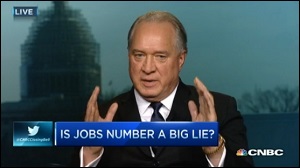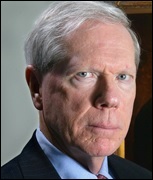By Pam Martens and Russ Martens: February 5, 2015

Gallup CEO, Jim Clifton, Worries Aloud on CNBC That He Might Disappear for Criticizing the Government’s Job Numbers
Years of unending news stories on U.S. government programs of surveillance, rendition and torture have apparently chilled the speech of even top business executives in the United States.
Yesterday, Jim Clifton, the Chairman and CEO of Gallup, an iconic U.S. company dating back to 1935, told CNBC that he was worried he might “suddenly disappear” and not make it home that evening if he disputed the accuracy of what the U.S. government is reporting as unemployed Americans.
The CNBC interview came one day after Clifton had penned a gutsy opinion piece on Gallup’s web site, defiantly calling the government’s 5.6 percent unemployment figure “The Big Lie” in the article’s headline. His appearance on CNBC was apparently to walk back the “lie” part of the title and reframe the jobs data as just hopelessly deceptive.
Clifton stated the following on CNBC:
“I think that the number that comes out of BLS [Bureau of Labor Statistics] and the Department of Labor is very, very accurate. I need to make that very, very clear so that I don’t suddenly disappear. I need to make it home tonight.”
After getting that out of the way, Clifton went on to eviscerate the legitimacy of the cheerful spin given to the unemployment data, telling CNBC viewers that the percent of full time jobs in this country as a percent of the adult population “is the worst it’s been in 30 years.”
Clifton drilled down further in his on line opinion piece, writing as follows:
“Right now, we’re hearing much celebrating from the media, the White House and Wall Street about how unemployment is ‘down’ to 5.6%. The cheerleading for this number is deafening. The media loves a comeback story, the White House wants to score political points and Wall Street would like you to stay in the market.
“None of them will tell you this: If you, a family member or anyone is unemployed and has subsequently given up on finding a job — if you are so hopelessly out of work that you’ve stopped looking over the past four weeks — the Department of Labor doesn’t count you as unemployed. That’s right. While you are as unemployed as one can possibly be, and tragically may never find work again, you are not counted in the figure we see relentlessly in the news — currently 5.6%. Right now, as many as 30 million Americans are either out of work or severely underemployed. Trust me, the vast majority of them aren’t throwing parties to toast ‘falling’ unemployment.
“There’s another reason why the official rate is misleading. Say you’re an out-of-work engineer or healthcare worker or construction worker or retail manager: If you perform a minimum of one hour of work in a week and are paid at least $20 — maybe someone pays you to mow their lawn — you’re not officially counted as unemployed in the much-reported 5.6%. Few Americans know this.
“Yet another figure of importance that doesn’t get much press: those working part time but wanting full-time work. If you have a degree in chemistry or math and are working 10 hours part time because it is all you can find — in other words, you are severely underemployed — the government doesn’t count you in the 5.6%. Few Americans know this.” (Read the full article here.)
Another bold truth teller when it comes to the jobs data is Dr. Paul Craig Roberts, the former Assistant Secretary of the Treasury and former Associate Editor of the Wall Street Journal. For years Roberts has written about the lack of attention to the measurement known as U6 – which covers the unemployed, underemployed and those who are not looking but want a job. That figure stood at 11.2 percent in December of last year, exactly double the official unemployment rate known at U3.
The fact that hourly earnings are not improving with the improvement in the official unemployment rate and that the labor force participation rate of working age men (ages 25 to 54) now stands at the lowest level since the BLS started keeping records more than 60 years ago adds further fodder to “The Big Lie” theory.


